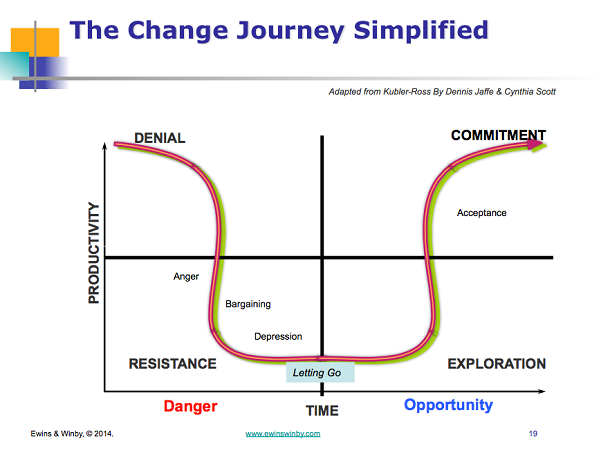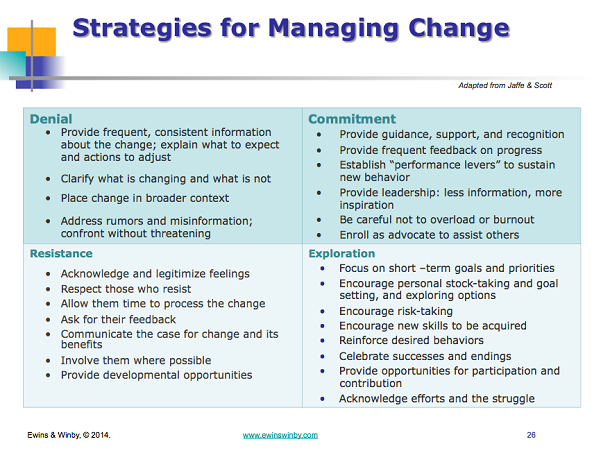So often I see organizational change management as a part of the implementation plan for putting the recommendations and new design of a Business Process Improvement project (BPI) into operation in a company. It should be there, but it needs to start sooo much earlier. In fact it needs to start with the first phase of a BPI project- namely in developing the charter and doing Process Discovery and Modeling.

I just participated in a workshop with a colleague, Anna Ewins of Ewins & Winby, on Organizational Change Management.
Workshop, organization development consultant Anna Ewins draws on the work of psychiatrist Dr. Elisabeth Kubler-Ross who researched how people deal with tragedy, bereavement and grief. Anna Ewins uses Ross’s model with application to organizational life by Dennis Jaffe & Cynthia Scott to illustrate the psychological responses people typically experience in one way or another when faced with change.

The personal change model developed by Kubler-Ross and simplified by Jaffe & Scott shows that we move through four stages: denial, resistance, exploration and commitment. If we perceive the change to be beneficial we are likely to move quickly from the first to the fourth stage. If not, we may be delayed considerably in denial and resistance. Ewins, who currently teaches a course at UC Berkeley Extension on Change Management with her business partner Mary Winby, shows us how we can use this model to both assess where an individual or group is in their personal change journey, and strategies for helping others move through change.
On the personal side, think of a change in your life and see how you journeyed through the four stages. One example could be the possibility of the need to change jobs. Your company has been bought out by another company and your job could be eliminated. In denial, you may be saying, “ I don’t think this will impact my job. It is critical to Finance and the other company will need to keep this department for six months to a year to make any transitions.” Then you find out you will be laid off in four weeks. Now you move into resistance. You could be saying, “Why was I so silly? I could have started the job search process several weeks ago.” Or “Maybe I can get another job in the new company and that’s where I could land for awhile.” Or “What do I do now? This is pretty depressing. I don’t know if my skills can transfer to something new.” All of these are examples of the resistance phase. With time, you move into exploration, as you begin to see new possibilities, start talking to friends and employees about ideas they have. Some of their ideas spur you own to explore similar jobs elsewhere or different opportunities in new job domains. The next stage, commitment, can come tentatively at first with your new energy. It can come when you land a new position or feel confident about the path you are exploring. Now as you are getting on with the next stage you see that it has possibilities and moves you in a positive direction.
Now let’s take these frameworks and relate them to the stages of a BPI effort. The first graphic with the BPI Project section is a guide here.
A BPI project begins with working with the Executive Sponsor, Process Owner, Project Lead, and BPM Facilitator to develop a charter that will provide project scope, process improvement goals, baseline measures and team members to work the project. During the charter formation the leaders list the key challenges they see in the process today, communicate the business case and why it is important for the business to make improvements to this process now. The Project Lead (a key manager who works the process and is a subject matter expert) should add to the challenges of the Process Owner. The joint charter formation creates a focus for the project, builds alignment around the current situation and articulates the expected outcomes for the project. In the Change Management framework below created by organization development consultant Anna Ewins, the Executive Sponsor and Process Owner, who have identified the need for the project have already moved to Exploration, but they are ahead of the Project Lead and other managers and employees. The charter helps the Project Lead and BPM Facilitator move toward exploration.

Then the Process Owner and Project Lead start the change process with the team members when they ask team members to join the BPI team. Then at the kickoff meeting, the team members (These are additional subject matter experts (SME) who work in the process, an IT person, data person, and a maverick.) review the Charter, see the high level process model and add to the list of challenges. The Process Owner reviews their SME roles for this BPI effort and acknowledges their value to the company in doing the process today. The Process Owner thanks each team member for helping to study the process and to make it better, as the SMEs on the team know the real work of the process and will have helpful recommendations.
The team members are probably in resistance at this stage. The charter and kickoff meeting acknowledge their concerns and incorporate their feedback into the charter. Then as the Project Lead, BPM Facilitator and team members begin Process Discovery techniques such as developing the As Is Swim Lane process model, and using the I-4 Lists give them a chance to voice complaints by recognizing issues and improvement ideas. The Swim Lane diagram provides a visual method of seeing how the whole process works together, including the part that each SME completes in their individual role. This is a method to reframe the situation for the team, moving from a problem with mistakes, blame, and lack of accountability to a process with many steps where different roles are contributing to the whole process which they can see in the Swim Lane process model.
During Process Analysis the team members use other analytical techniques to gather data and metrics, hear the voice of the customer, identify wastes and inefficiencies. The team begins to see common problem areas and issues at different steps or subprocesses in the process. They are learning the skills of process improvement. They should identify some quick wins and implement them early on (after three to four meetings) in the BPI project. They are being engaged and their ideas are valued. All of these elements move them into exploration.
And after modeling the current state and analyzing it using the relevant techniques, it is time to formulate the Future State, or how the team wants the process to be in the new design. Of course this new design needs to meet the improvement goals set by the Process Owner, respond to the voice of the customer, and have metrics showing the improvements over the baseline data. (All of these are now part of the charter.) This stage is part of commitment. Commitment also goes farther; it includes socializing the new design with other employees and managers, the implementation plan, identifying data to track to monitor the level of success after implementation, and determining data continue to ensure results are maintained.
Yet, the project stage of implementation is not the beginning of the Change Management Plan. Identifying and engaging the leaders and team at the beginning of the BPI project enable early and ongoing communication, establish advocacy for the project, and build involvement and reality into the project for leaders and employees who are team members. That means when the BPI gets to implementation there already is a strong foundation of Change Management. Then implementation takes it to its next stages, expanding the stakeholder groups that will be involved. But many of the stakeholders have already had communication and engagement about the project with the BPI leaders and team members. This does not mean that there will be no resistance, but some managers and employees many have worked through denial and even resistance, instead of just beginning during implementation. So start Organizational Change Management early and have a plan to follow during all the stages of the BPI Project.

















